An exponential moving average (EMA) technical indicator reduces the lag associated with simple moving averages (SMA) by applying a multiplier to the most recent data. EMAs provide improved sensitivity, enhancing the accuracy of trend analysis.
Can traders rely on EMA as an indicator? I tested 30 Dow Jones stocks and 4 EMA settings over eight years, equalling 64,680 test trades, to analyze success rates and the best settings in pursuit of an answer.
What is an Exponential Moving Average?
An exponential moving average (EMA) is a trend-following indicator that tracks the average price of an asset over a given period. The EMA is calculated by taking a certain percentage of the closing price and adding it to the previous EMA calculation. This method gives more weight to recent data points than older ones, making it more reactive to price changes than a simple moving average.
The EMA is used to smooth out short-term price fluctuations and filter out noise from the underlying trend.
Although traders have used the exponential moving average to identify market trends, this strategy falls short. It’s not recommended as a tool for determining when to buy and sell assets based on their historical performance.
Instead, it’s best used as a support or resistance indicator, offering insight into potential price movements. Remember, successful trading strategies incorporate multiple indicators for decision-making.
KEY TAKEAWAYS
- The EMA adds an exponential weight to the most recent price closes.
- EMAs work well on strongly trending markets and equities.
- EMAs tend to underperform in range-bound markets.
- According to our testing, I advise against using the EMA as a trading tool as it is inaccurate and can lead to traders losing money.
- Traders should use longer EMAs to identify the overall trend and shorter EMAs for more short-term price movements.
Understanding Exponential Moving Averages?
The exponential moving average (EMA) is a commonly used technical financial analysis tool that gauges a stock’s average price over a certain period. It provides insight into the direction of long-term asset price trends. If the price is above the EMA, it indicates a rising trend, potentially a suitable time to buy. However, prices below the EMA may represent a good time to sell.
The moving average period is crucial in determining the reliability of stock price trends. Consider a 200-day moving average to determine general uptrends – if the price consistently sits above, you can expect a bullish signal. For those looking to sell, use a 50 or 20-day moving average and watch for when prices slip below the line.
Example Chart: 3 Exponential Moving Averages
This chart shows the exponential moving average traffic light system. Three moving averages are plotted on the chart: the 10-period EMA in green, the 50-period EMA in amber, and the 100-period EMA in red.
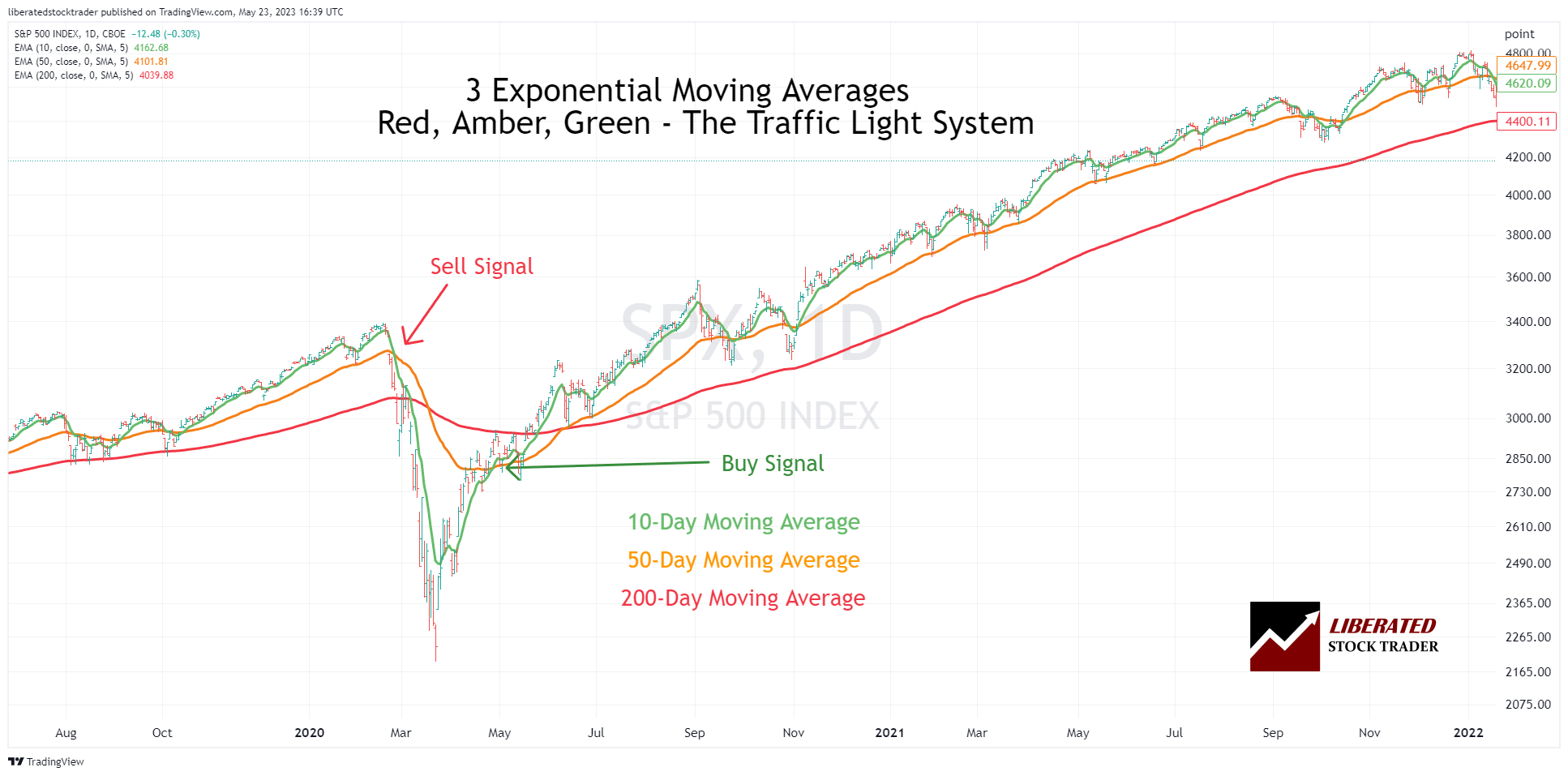
Get Moving Average Indicators on TradingView
Pros
One of the main advantages of using an exponential moving average is that it’s easy to calculate. Most charting software packages already have the calculations built-in, so there’s no need for complicated formulas or manual calculations. The EMA also provides a clear visual representation of price trends, which can be easier to interpret than other types of technical analysis.
Cons
One major drawback of using moving averages is that they tend to underperform during market or stock price consolidation periods, which can translate to negative returns.
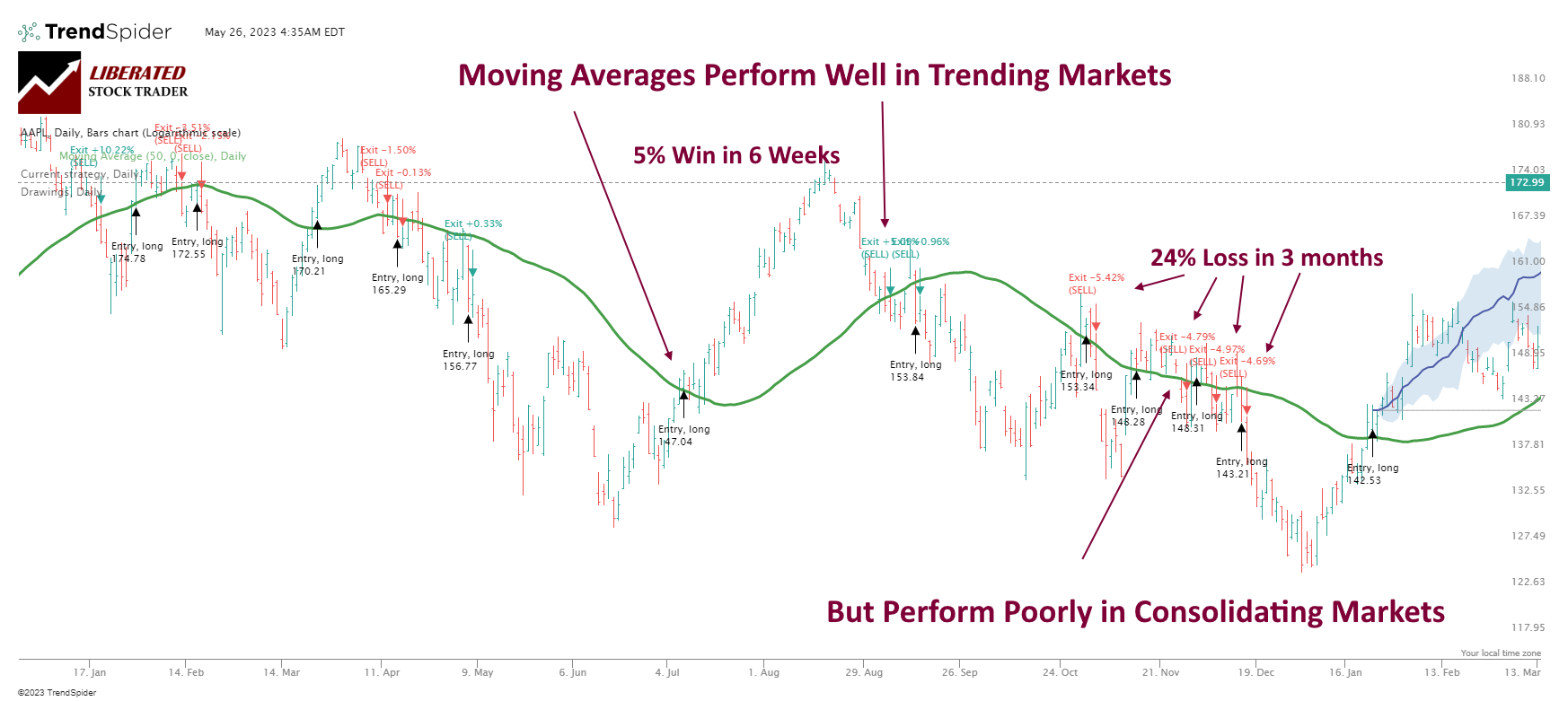
Trade Testing Performed With TrendSpider
However, one of the drawbacks of using the EMA is that it doesn’t consider short-term volatility. Prices can gyrate wildly in the short term, but a long-term average like the 200-day EMA might not capture these swings. Investors relying solely on an EMA may miss important short-term buying and selling opportunities. Additionally, the EMA is a lagging indicator, meaning it can only confirm trends after they’ve already started. This means investors must use other indicators in conjunction with an EMA if they hope to stay ahead of the markets.
My thorough testing awarded TradingView a stellar 4.8 stars!
With powerful stock chart analysis, pattern recognition, screening, backtesting, and a 20+ million user community, it’s a game-changer for traders.

Whether you're trading in the US or internationally, TradingView is my top pick for its unmatched features and ease of use.
Explore TradingView – Your Gateway to Smarter Trading!
Calculation
The formula for calculating an exponential moving average is:
EMA = (Closing price – EMA(previous day)) x multiplier + EMA(previous day)
Example: If we wanted to calculate the 5-day EMA, we would take the closing price on the latest trading day, subtract the 5-day EMA from the previous day, and then add the result to the 5-day EMA of the previous day. We would then multiply this sum by a multiplier based on the number of periods in our moving average (in this case, five). The resulting figure represents our current 5-day EMA.
The multiplier is calculated using the following formula:
2 / (number of periods + 1)
For example, in the case of a 5-day exponential moving average, the multiplier would be 2/6 = 0.33. Each day’s price will contribute one-third (0.33) of the overall EMA value.
Using this example, if Apple’s closing price on the current trading day is $200, and its 5-day EMA from yesterday was $150, we would calculate our 5-day EMA for today as follows:
($200 – $150) x 0.33 + $150 = $170
Therefore, today’s 5-day EMA is $170. We can use this figure to compare with Apple’s current trading price and determine whether the stock is overbought or oversold. If the 5-day EMA exceeds the current trading price, the stock is oversold and may be a good time to buy. Alternatively, if the 5-day EMA is lower than the current trading price, the stock is overbought and may be a good time to sell.
How to trade EMA
Traders often use EMAs as entry and exit points. When prices move above the EMA, it indicates an uptrend; when prices move below the EMA, it suggests a downtrend. Crossovers are also used as signals for entry or exit points. A buy signal is generated when the shorter-term EMA crosses above the longer-term EMA, and a sell signal is generated when the shorter-term EMA crosses below the longer-term EMA.
Example Chart: Trading Using an Exponential Moving Average
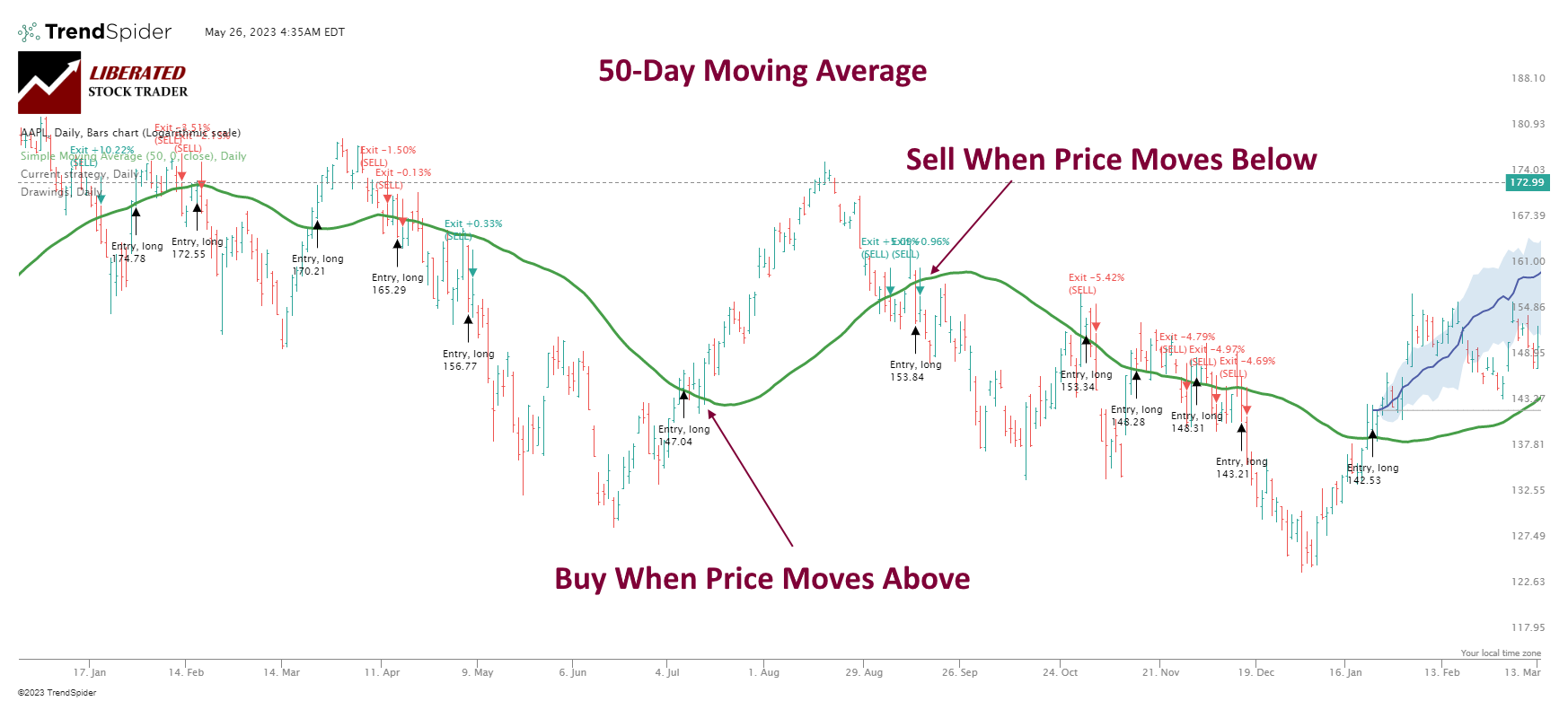
Is the EMA Accurate?
No, the exponential moving average indicator is inaccurate, averaging only a 7% win rate. When asset prices consolidate, the EMA causes many small losses, and good entry points are missed. Backtesting the EMA indicator on 30 Dow Jones Industrial Average stocks over eight years resulted in an average 7% win rate, meaning it underperformed a buy-and-hold strategy 93% of the time.
EMA Backtesting Methodology
I used TrendSpider, the leading AI stock trading software with pattern recognition and a codeless backtesting engine, to backtest the EMA indicator. Testing was configured using OHLC with an exit on the next open. The Heikin Ashi daily chart used the exit criteria for the next trading day, HL2 (Price High + Low /2).
| Testing Criteria | Daily OHLC Chart | Daily Heikin Ashi Chart |
| Index: | DJIA | DJIA |
| Date Range | 8 Years/2000 Candles | 8 Years/2000 Candles |
| Settings: | 20, 50, 100, 200 | 20, 50, 100, 200 |
| Entry Criteria: | Price > EMA 20 | Price > EMA 20 |
| Exit Criteria: | Price < EMA 20 | Price < EMA 20 |
| Sell: | Next Open | High+Low/2 |
I test all indicators, including the EMA, using their standard recommended settings, different timeframes, and different chart types; this provides an unbiased result. Also, the entry and exit prices use an average of the high and low prices for the day, making the testing more realistic.
How I Set Up EMA Backtesting in TrendSpider
To set up backtesting in TrendSpider, follow these exponential steps. Register for TrendSpider, select Strategy Tester > Entry Condition > Add Script > Add Parameter > Condition > Price > Greater Than > EMA. For the Sell Criteria, select > Add Script > Add Parameter > Condition > Price > Less Than > EMA. Finally, click “RUN.”
To set up backtesting, I used TrendSpider, our recommended trading software for serious traders. The screenshot below shows the exact configuration for our EMA backtesting.
Testing EMA on OHLC Charts
Below is a typical example of a 200-day EMA on an OHLC chart. Over eight years, a trader using the 50-day exponential moving average McDonald’s Corp. (Ticker: MCD) would make 84%, but a buy-and-hold investor would have made 199%. The average results for the exponential moving average mean it is a poor choice for trading using candlestick charts.
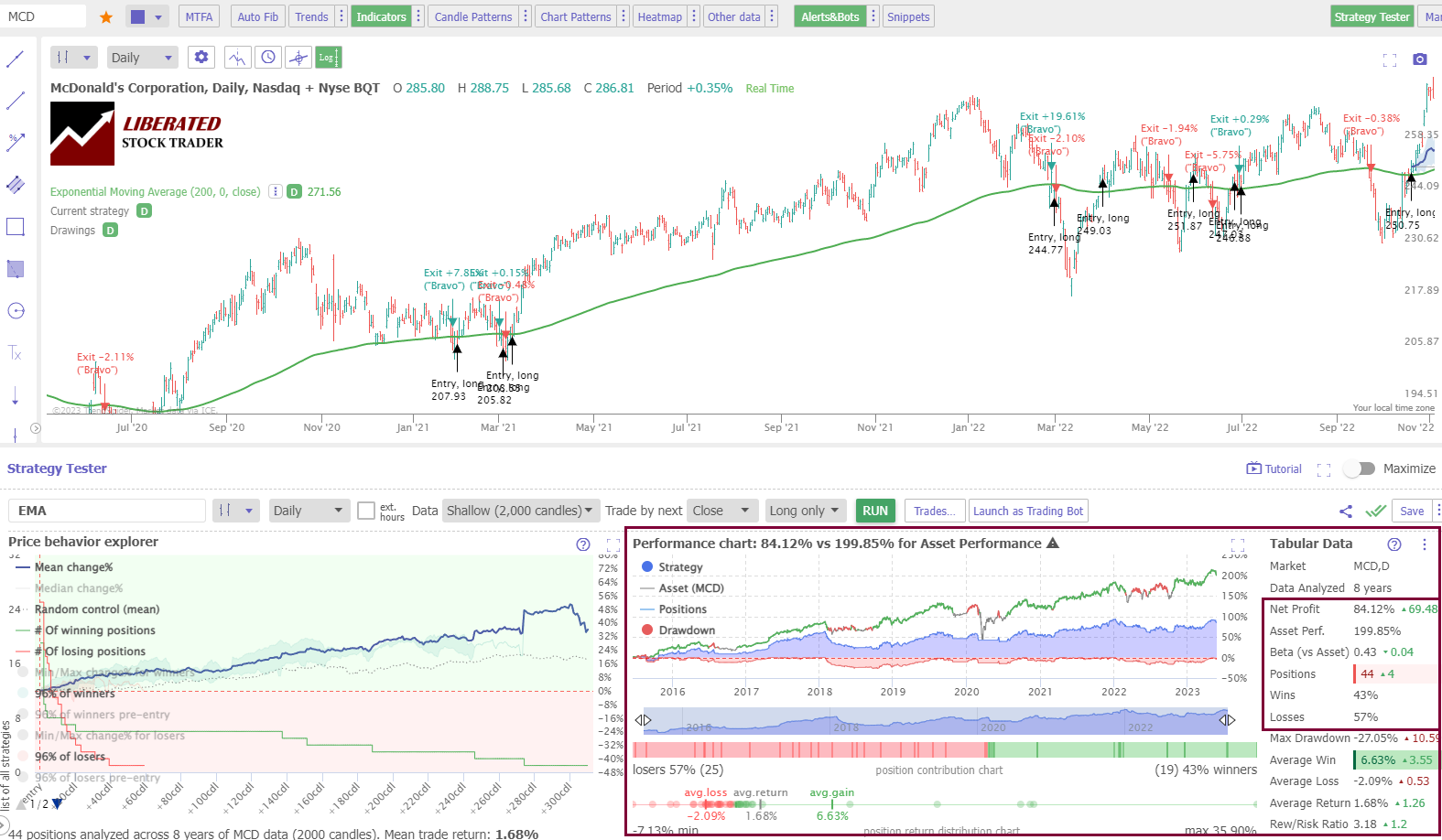
Strategy Testing Performed With TrendSpider
Testing the standard EMA settings on a daily candlestick/OHLC chart proves this indicator is poor, with a 7% chance of outperforming a buy-and-hold strategy on all tested timeframes.
EMA Backtesting Results for Daily OHLC Charts
Testing 960 years of data shows the average win rate for exponential moving averages is 7%. The table below shows that the EMA 20 has a 23% chance of beating a buy-and-hold strategy, and the 200-day EMA only has a 0% chance of success.
| 8-Year Backtest OHLC Chart | % Win Rate | # Trades |
| Timeframe: | Daily | Daily |
| 20-Day EMA | 23% | 160 |
| 50-Day EMA | 3% | 73 |
| 100-Day EMA | 3% | 52 |
| 200-Day EMA | 0% | 23 |
| Average | 7% |
I tried many backtesting solutions, but this testing was only possible using TrendSpider.
Testing EMA on Heikin Ashi Charts
The exponential moving average performs better on a Heikin Ashi chart, but the overall results are still poor. If a trader used the 200-day moving average on Apple Inc. (Ticker. AAPL) over eight years, they would have made a 592% profit, beating a buy-and-hold strategy profit of 442%.
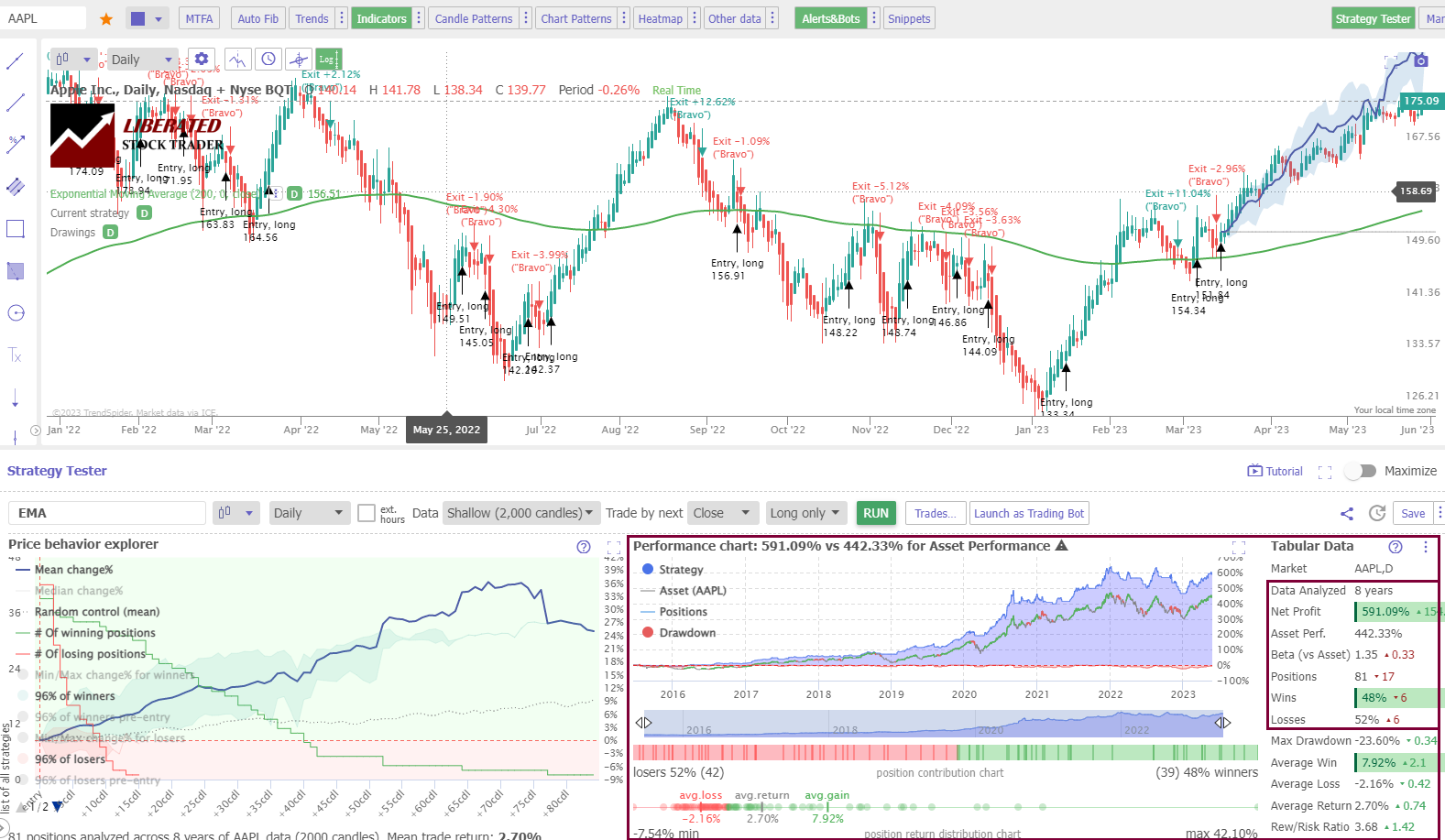
The table below shows that even using the advantages of Heikin Ashi charting, the exponential moving average indicator should be avoided.
EMA Backtesting Results for Heikin Ashi Charts
Testing 960 years of data shows the average win rate for exponential moving averages on a Heikin Ashi chart is 39%. This means 61% of stocks traded using this strategy will fail to beat a buy-and-hold strategy.
| 8-Year Backtest Heikin Ashi Chart | % Win Rate | # Trades |
| Timeframe: | Daily | Daily |
| 20-Day EMA | 83% | 111 |
| 50-Day EMA | 37% | 61 |
| 100-Day EMA | 27% | 51 |
| 200-Day EMA | 10% | 32 |
| Average | 39% |
Why are Heikin Ashi’s EMA results better?
Why do Heikin Ashi charts perform slightly better with EMA and other indicators like Keltner Channels and Price Rate of Change? I believe it is because price averaging removes the extreme price highs and lows associated with traditional OHLC bars. This means fewer trades in consolidating markets and fewer small losses.
Professional traders may assume, as I did, that the Heikin Ashi chart distorts the pricing because it averages the OHLC of the candles. But we can achieve realistic entry and exit criteria by using TrendSpider’s HL2 setting, meaning the average of the price candle high and low. I proof-checked individual trades, which were reasonable but not entirely realistic.
Combining EMA with Other Indicators
Incorporating the EMA with additional chart indicators, such as bullish chart patterns, is optimal. The EMA excels in markets trending either up or down. However, it provides multiple false buy and sell signals during consolidation, leading to many minor trading losses. Therefore, avoid using this indicator during consolidating markets.
Should you Buy and Sell with EMA?
No, my research backtesting shows that the EMA is a poor indicator for identifying buy and sell signals. Using 960 years of data across 30 Dow Jones stocks, the EMA lost to a buy-and-hold strategy 93% of the time. EMA is a very poor indicator by a significant margin.
The Best EMA Settings
Our research shows that the best setting for the EMA indicator is a 20-day period on a Heikin Ashi chart. This setting is the only one that outperforms a buy-and-hold strategy with an 83% win rate. All other settings on OHLC charts and timeframes produce losses and a failure rate of 67%.
Although the EMA isn’t the most reliable indicator, the optimal solution is to choose the least bad option. If it is necessary to use this indicator, it is recommended to set it according to period 20 and utilize a daily Heikin Ashi chart.
This indicator is most effective when the asset moves in strong trends. Whenever the asset goes through a period of price consolidation, many small losses will likely be incurred.
Limitations
The biggest limitation of moving averages is they produce 82% of their losses in consolidating markets. Markets only have 2 phases: trending and consolidation. Moving averages should not be used when an asset’s price is consolidating.
Summary
After testing for 960 years, it’s safe to say that using exponential moving averages as trading indicators for buying and selling is a losing strategy. Avoid it. You only have a 7% chance of outperforming a buy-and-hold strategy.
You may also be interested in the incredible alligator indicator based on moving averages; with the optimal settings, it has proven highly profitable.
FAQ
Is the exponential moving average the same as a moving average?
No, an exponential moving average is not the same as a moving average. There are four core moving averages; simple, exponential, weighted, and Hull moving averages. The exponential moving average is a subset of the moving average indicators.
Do exponential moving averages really work?
No, according to our testing, exponential moving averages work out very poorly for anyone trading them on a daily or even intraday 5-minute chart. Using EMA on a daily OHLC or Candlestick chart is a poor predictor of price trends and direction reversals, losing out to a buy-and-hold strategy 93% of the time.
How accurate is an exponential moving average?
The exponential moving average indicator is extremely inaccurate, especially with a standard OHLC, line, or candlestick chart. Our research indicates that an EMA has a 7 to 23 percent win rate. Although moving averages and MACD are marketed as good strategies, the rate of change indicator is more effective at 66 percent.
How to make money trading moving averages?
Our research demonstrates that making money using moving averages is unlikely because this indicator generates many losses during market consolidations. The simple moving average win rate is 12%, while the exponential moving average is only 7%.
How to use exponential moving averages with Crypto or Forex?
You can use EMAs with cryptocurrency or Forex trading, but our tests show the results are poor, with only a maximum success rate of 23% on a 20-period setting. Whether you choose stocks, crypto, or forex for trading, you must avoid the EMA strategy.
Is the exponential moving average a good indicator?
No, our research shows that exponential moving averages are not good indicators on any timeframes. We tested the 20, 50, 100, and 200-day moving averages, and all results were less than a 23% win rate.
What are better indicators than exponential moving averages?
There are many better indicators than exponential moving averages, such as the rate of change (ROC). Our testing has proven these indicators to be much more effective, work on many timeframes, and are more successful in trading strategies.
Is an exponential moving average the best indicator?
No, the exponential moving average is not the best indicator; it is one of the worst indicators in technical analysis. It generated 58 percent losing trades when trading the DJ Industrial Average. For trading success, learn how to backtest and tune trading strategies.
What is the best time frame for exponential moving averages?
The best timeframe for an exponential moving average strategy is a daily Heikin Ashi chart with a period of 20, which yields an 83 percent win rate according to our testing. We conducted time-based research and found that EMAs underperformed the market on all timeframes on all candlestick charts.
How reliable is an exponential moving average?
Exponential moving averages are an incredibly unreliable technical analysis chart indicator. Our 960 years of backtested data on 30 major US stocks show a 7% chance of beating a buy-and-hold strategy on a daily OHLC chart and a 39% chance on a Heikin Ashi chart. Testing confirms it is an unreliable indicator and should be avoided.
What is the best software for testing EMA/SMA indicators?
After carrying out a thorough analysis of moving average trading, we utilized TrendSpider, a premier trading tool for backtesting and strategy development. As a professional, in my opinion, it proved invaluable.
Which is better, an exponential or simple moving average?
Based on 1,820 years of backtesting data on 30 stocks, our research indicates that the Simple Moving Average (SMA) outperforms the Exponential Moving Average (EMA) with a 12% win rate as compared to the EMA's 7%. Both indicators have poor success rates and are not recommended for traders.
How to read an exponential moving average chart?
To read an exponential moving average chart, note a price above the moving average line signals an uptrend; below the line could indicate a downtrend. Only use moving averages when the asset is in a strong trend to avoid small losses.
What is the best software for trading moving average indicators?
TrendSpider is hands-down the top software for trading moving average indicators, with 15 indicators and integrated point-and-click backtesting; you can see why it's a game-changer! TradingView is also good, offering 10 moving average indicators and a global community of traders to learn from.
What is a period in an exponential moving average?
The period in an exponential moving average (EMA) is the number of data points used to calculate the EMA. If you use a 20-day EMA, you will be averaging out the last 20 days of price action. A longer period, such as a 200-day EMA, will calculate 200 periods on a daily chart.
Are daily and exponential moving averages the same?
No, daily and exponential moving averages are not the same. An exponential moving average uses a chart timeframe in its calculation. If the chart is a daily chart, then the EMA-5 uses five periods of one day. But if you use a 5-minute chart, the EMA-10 calculates ten 5-minute periods.
Do traders use exponential or exponential moving averages?
Beginner traders will use simple or exponential moving averages. But experienced traders who have performed their backtesting will avoid using these moving averages due to their poor performance in consolidating markets and low win rates of only 7%.
How to calculate a 10-month exponential moving average?
To calculate a 10-month EMA, set your chart to monthly and select your exponential moving average to be 10. Alternatively, on a daily chart, set the exponential moving average period to 200. There are approximately 20 trading days per month, multiplied by 10 months.
